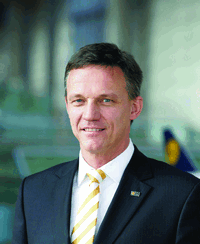Including aviation in Europe's emissions trading system without implementing the Single European Sky will undermine the ability of airlines to renew their fleets, says Karsten Benz, vice-president sales and services Europe at Lufthansa
In light of growing demand for mobility, the aviation industry must respond to new environmental policy challenges with the focus on further reducing greenhouse gas emissions, noise pollution and energy consumption. Striking a balance between economic interests and environmental responsibility remains the guiding principle for our industry. Unfortunately, one field which has not been successfully tackled by the European Union and its member states is the structure of the European airspace. The skies over Europe are still fragmented and, as a consequence, flights are up to one-third longer than they need to be. Only a Single European Sky can help in reducing queues to take off or land.
But SES would not only reduce delays for passengers, it would also remove a substantial amount of unnecessary CO2 emissions from the atmosphere. We have therefore welcomed the second package of SES legislation that was adopted in June by the European Commission. The lengthy process to rationalise and modernise Europe's patchwork airspace has taken a significant step forward.
Under the current system, European airspace is carved up into 58 small, country-shaped parcels, each overseen by its own control centre. Up to 22 different operating systems are used, which result in inefficiencies at every turn within airspaces and at the interface between airspaces. Due to this situation, flight path detours with a total length of 468 million kilometres (291 miles) were flown in 2007, causing 4.7 million tonnes of additional CO2 emissions - not counting the unnecessary holding patterns.
 |
|---|
"Single European Sky is the largest environmental protection project ever"Karsten Benz |
State-of-the-art technology on board aircraft and high-performance radars on the ground operate at a fraction of their capabilities due to the constraints imposed by these virtual frontiers in the air. The anticipated 11.9 million flights within Europe in 2010, rising to 15.8 million in 2020, cannot be handled anymore by the existing system.
The commitment to the SES process comes at a crucial time for the European airline industry - but still quite late. Rocketing fuel prices are driving up airline costs at an alarming rate, and triggering economic effects which are impacting consumer demand. Airlines cannot continue to be burdened with the huge costs of en-route inefficiency, needlessly burning fuel.
At Lufthansa alone, these air traffic control inefficiencies on the ground and in the air are causing unnecessary fuel waste comparable to 11 widebody flights from Frankfurt to New York per day. In total, more than one-tenth of the carbon footprint of Europe's airlines was caused by fuel dissipation in the mismanaged airspace.
No one should forget that the Single European Sky is the largest environmental protection project ever. European politicians must realise that SES is closely connected to their ambitious climate change targets, while emissions trading will only have an impact on air transport if it is implemented worldwide a global problem cannot be solved with a local solution.
Unfortunately the decisions made in July by the European Parliament have shown a different result and turned the situation upside down: a cost-increasing ETS will be implemented by 2012, while a cost-reducing SES is only planned for 2020. Adding billions to the industry's cost base in a single stroke will lead to bankruptcies and liquidations, which will result in communities losing air service and regional economies being harmed.
Route Inefficiencies
Equally important from an environmental perspective is that for every year SES remains unrealised following the inclusion of aviation in the ETS, airlines will have to acquire permits for an estimated 12 million tonnes of CO2, arising from route inefficiencies.
Including aviation in the ETS without the simultaneous implementation of SES will undermine the ability of airlines to invest in more fuel-efficient aircraft. Instead of replacing existing fleets with the latest aircraft types and next-generation engine technologies, carriers will have to purchase emissions certificates. Lufthansa's investment of more than €14 billion ($22.3 billion) over the next seven years in 170 of the world's most efficient aircraft is only possible without a distortion of competition between Europe and the rest of the world.
Airlines have developed a comprehensive strategy encompassing green technology, operational best practice and the absolute need to improve the efficiency of Europe's air traffic management through SES. These pillars could stand alongside an appropriately designed ETS that could serve as a blueprint for worldwide application.
To read our earlier feature on the ins and outs of the Single European Sky project, go to: flightglobal.com/ses
Source: Airline Business



















